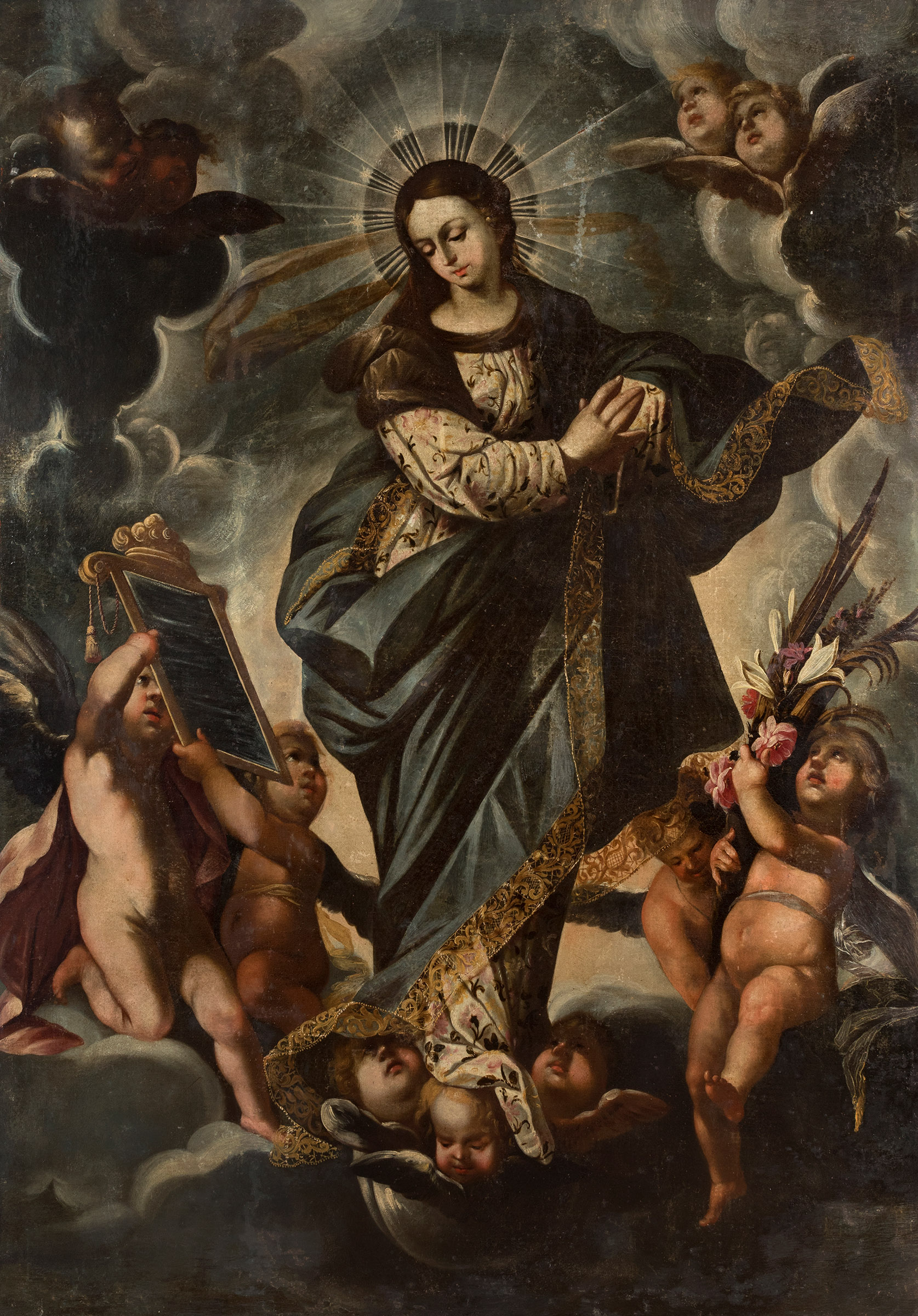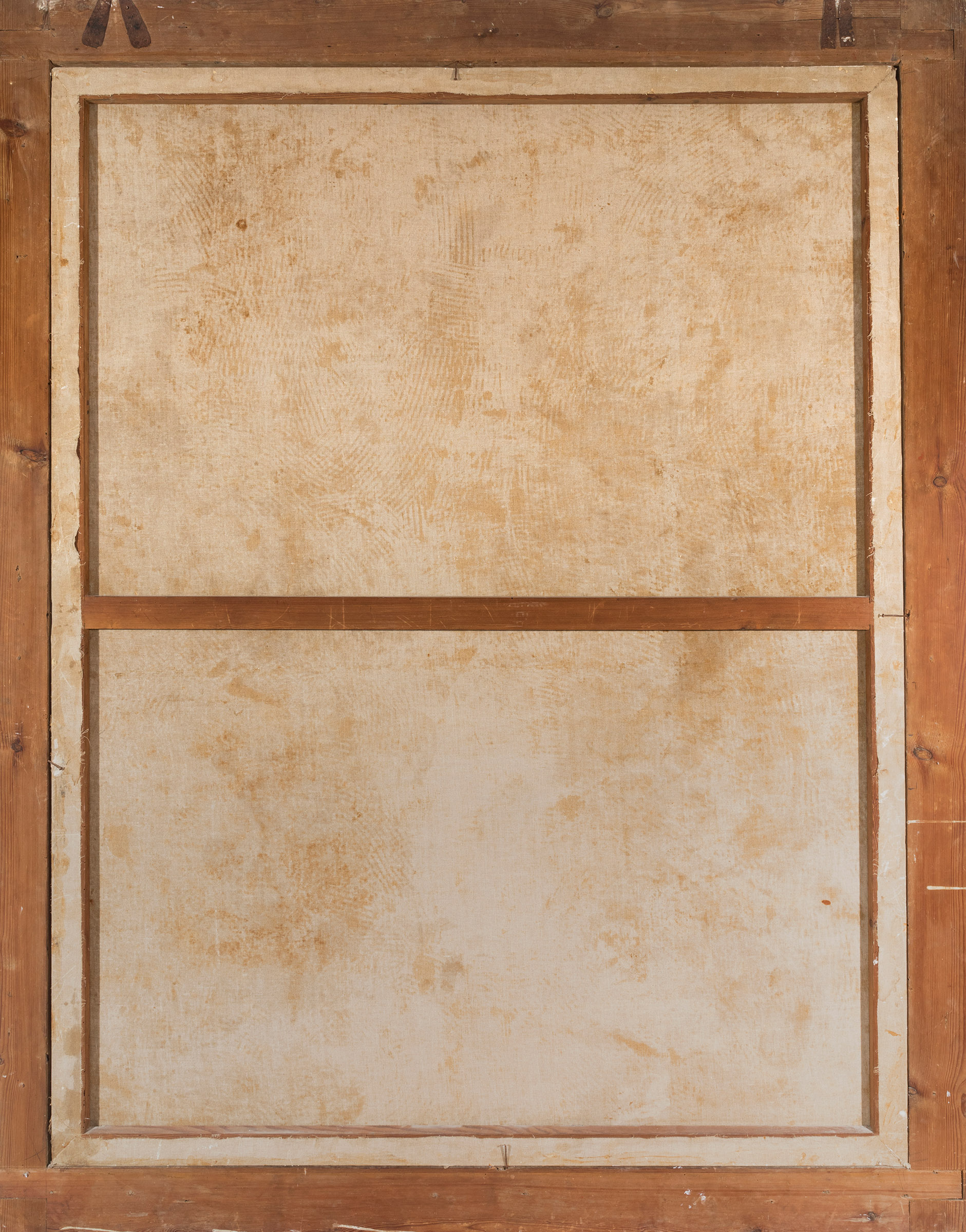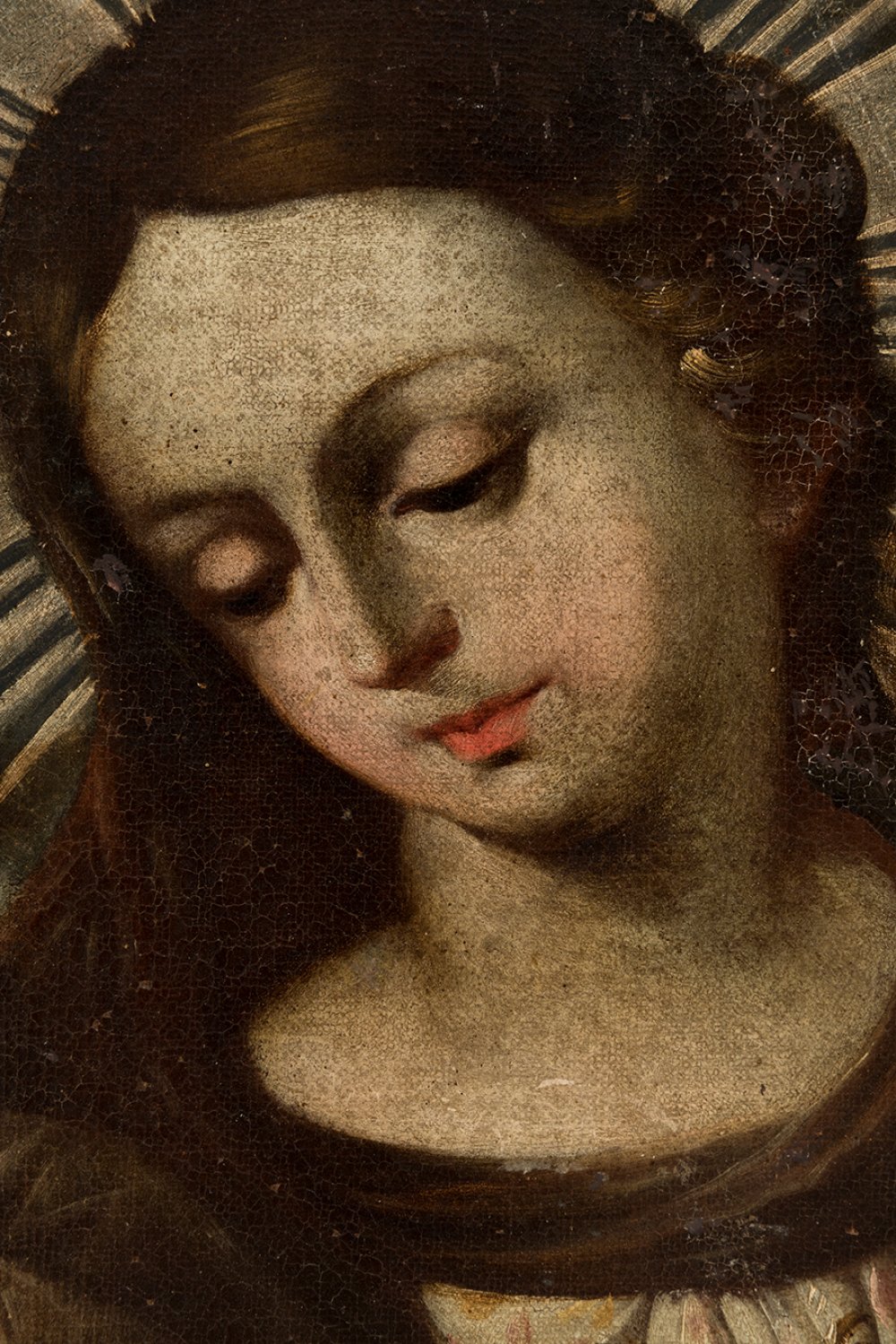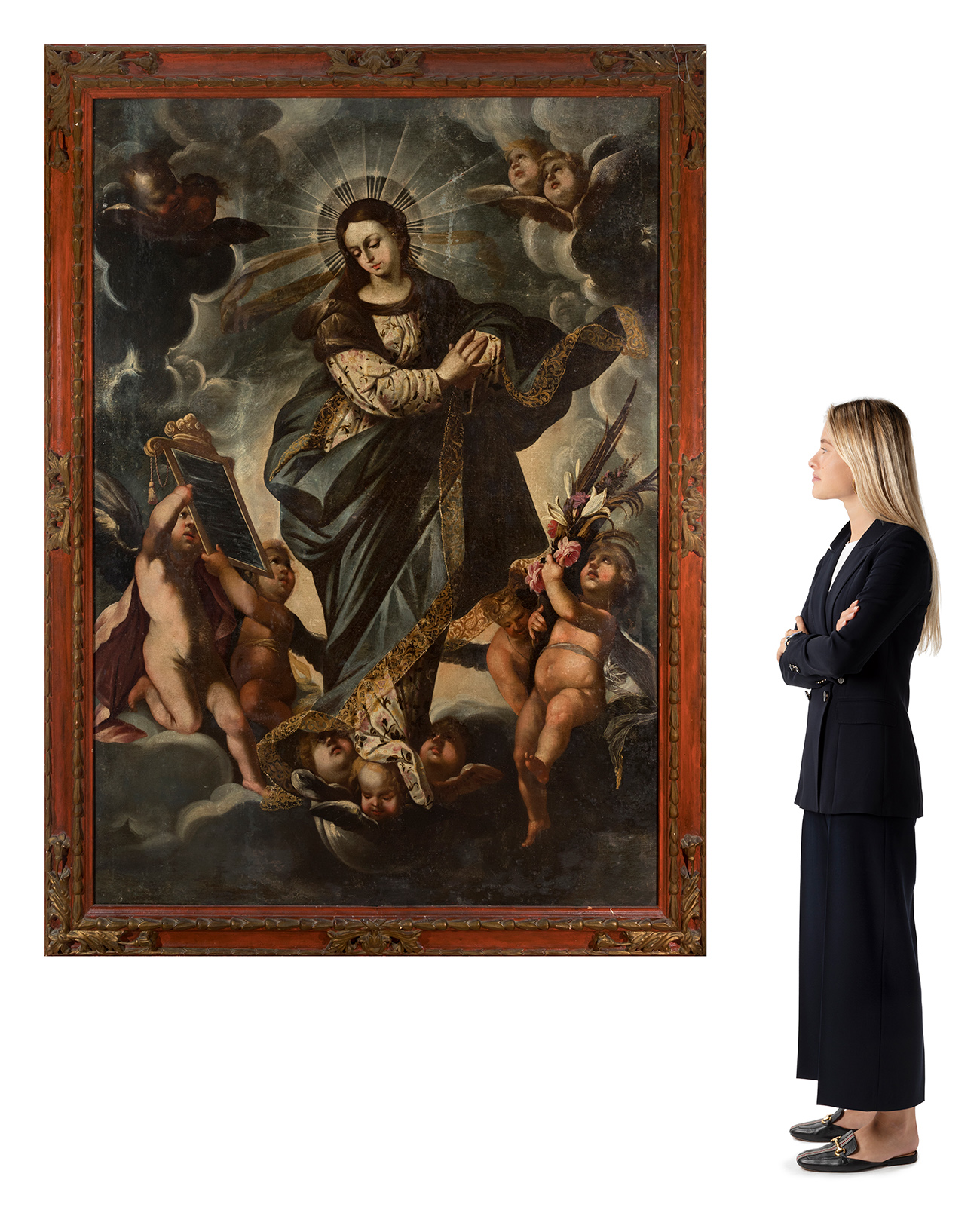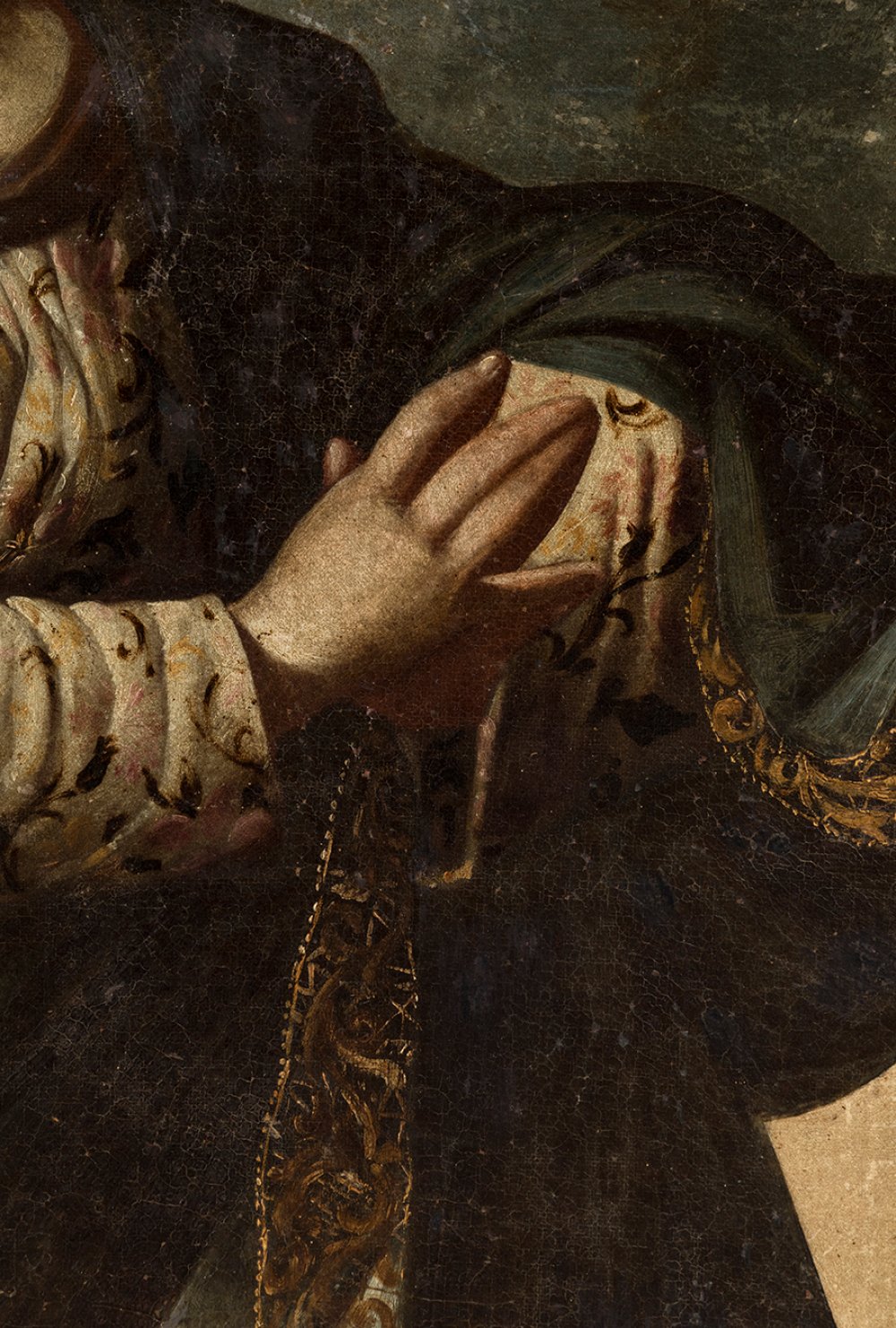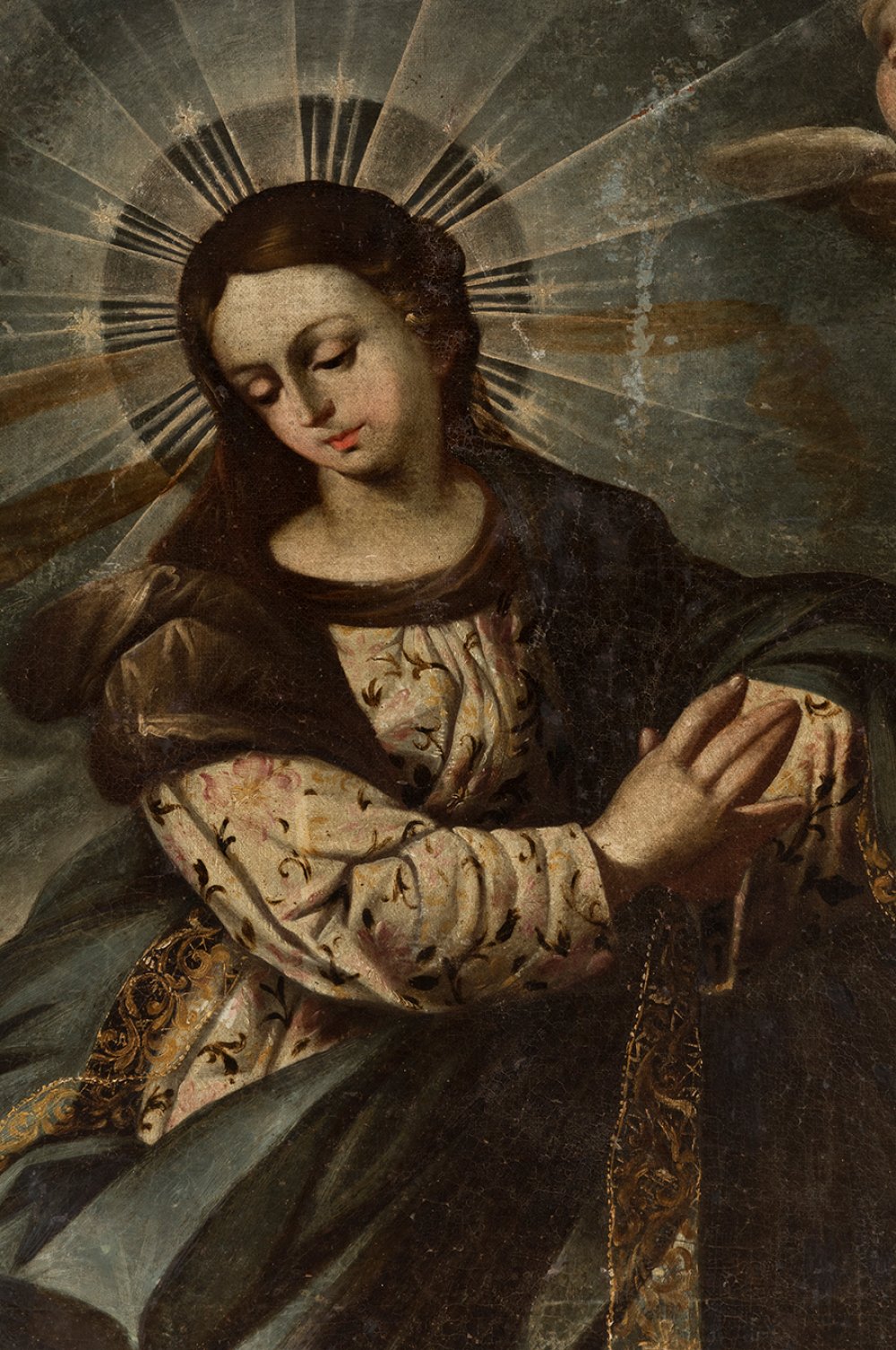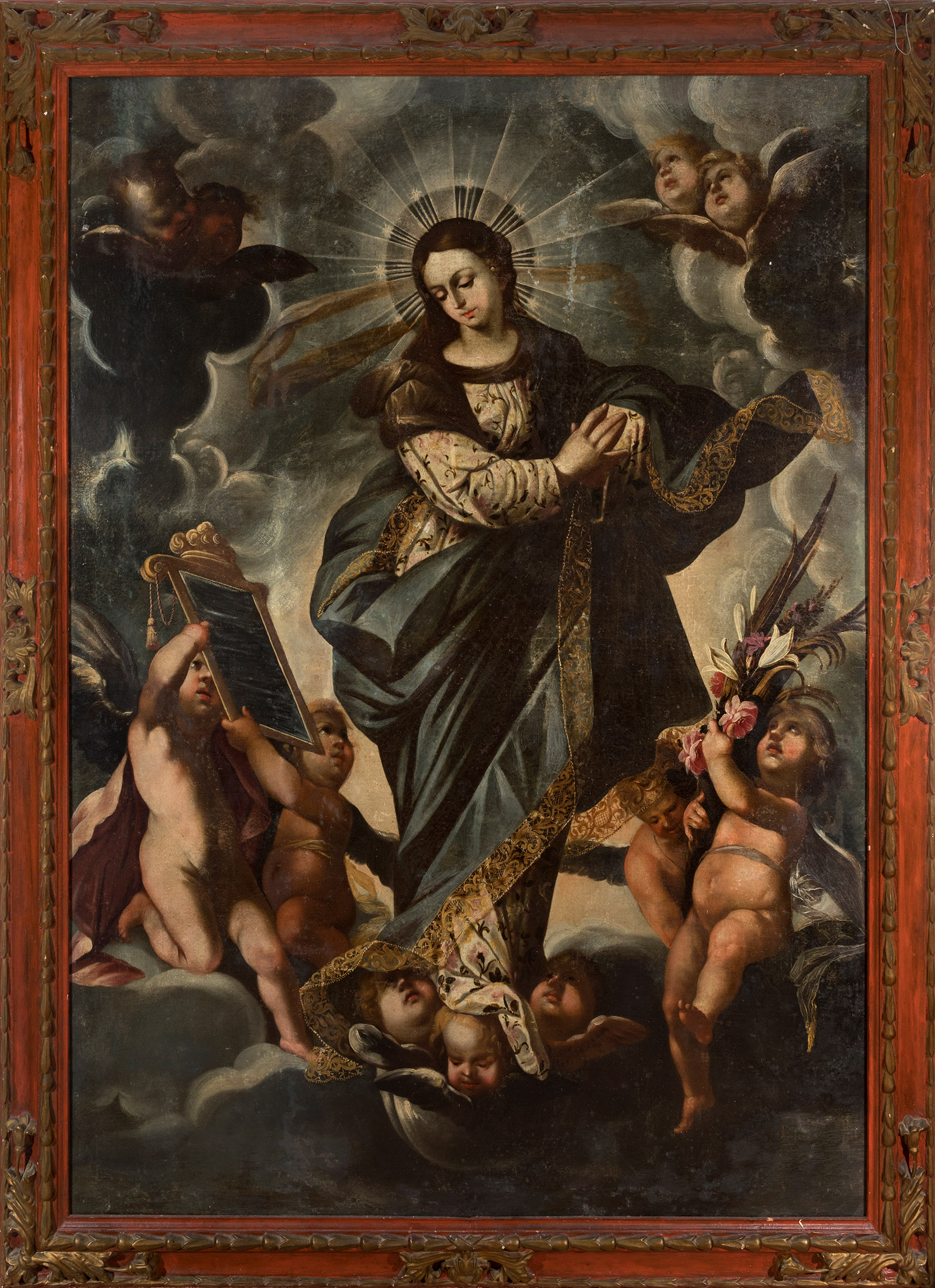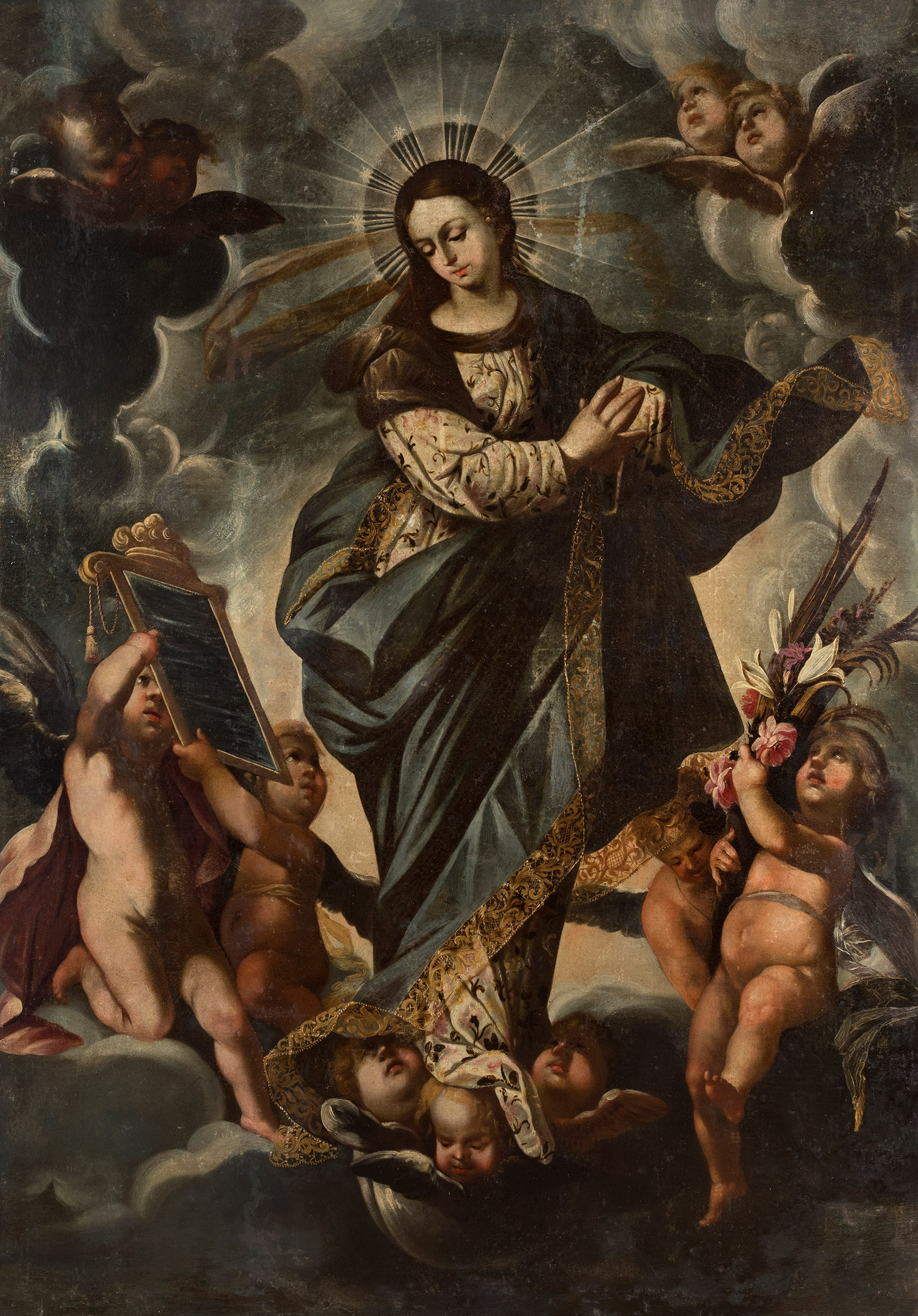5
School of JOSÉ ANTOLINEZ (Madrid, 1635-1675), End of the 17th century."Immaculate Conception".Oil on
"Immaculate Conception".
Oil on canvas. Re-retouched.
It presents restorations, repainting and faults on the pictorial surface.
It conserves a period frame with later polychromy.
Measurements: 187 x 142 cm; 211 x 166 cm (frame).
The Virgin joins her hands piously, while she turns her face downwards, surrounded by angles in the sky, the mother of God appears majestically as the Immaculate Conception. The piece is remarkable for the tactile quality of the Virgin's clothing, especially the tunic, which is richly embroidered with flowers on the immaculate white. The Dogma of the Immaculate Conception was strongly introduced in Spain during the Counter-Reformation, which led to numerous iconographic representations of the Virgin Mary. Many artists worked on this theme, including Pacheco, Murillo, Velázquez, Valdés Leal and Francisco de Solís himself. Antonílez, in particular, has always been noted for the large number of works he devoted to the Immaculate Conception, of which around twenty have been preserved, three of them signed in the Museo del Prado. He succeeded in creating an iconographic type of his own, extremely elegant and refined, in which the Virgin appears with a concentrated countenance, sweetly self-absorbed despite the busy group of angels surrounding her.
The piece is close to the precepts of José Antolínez, who was one of the most interesting artists of his generation who, due to his early death, was unable to reach the splendid maturity that his training foreshadowed. This does not prevent him from being considered a great representative of the full Baroque current that renewed painting at the Spanish court during the third quarter of the 17th century. In his work we can perceive the exquisite sensitivity for the recreation of Titian's manners - always so present in the Spanish painting of his time - combined with the reception of the elegant painting of the Nordic masters Rubens and Van Dyck, and the capture of the atmosphere of Velázquez. In this way, his technique is loose and vibrant, singularly seductive in the use of cold tones, which unfold in compositions full of vigorous movement and unstable activity. We know of his father's work as an artisan carpenter, when the family was established in Madrid's Calle de Toledo, although with a manor house in the village of Espinosa de los Monteros in Burgos. Palomino has conveyed to us the image of a person of a haughty and conceited nature, so aware of his own worth that he was often arrogant, an attitude that would cause him numerous frictions and disputes with other colleagues. He was a pupil of Francisco Rizi, with whom he also fell out, although this did not prevent his painting from being highly appreciated by his contemporaries. He cultivated all genres: religious painting, landscape painting - of which there are no surviving examples - mythology, portraiture and genre painting. Also worthy of note in the field of portraiture are the two children's portraits in the Museo del Prado. These are works that show both the truthful closeness of the figures and the capturing of the atmosphere that surrounds them, to such an extent that they were considered works by Velázquez until recently when they were attributed to Antolínez by Diego Angulo. Of the canvases in the Prado Museum, "The Transit of the Magdalene" and the two children's portraits come from the royal collections and two of the Immaculate Conception belonged to the Museo de la Trinidad, while the third was acquired in 1931 with the funds bequeathed by Aníbal Morillo y Pérez, 4th Count of Cartagena.
"Immaculate Conception".
Oil on canvas. Re-retouched.
It presents restorations, repainting and faults on the pictorial surface.
It conserves a period frame with later polychromy.
Measurements: 187 x 142 cm; 211 x 166 cm (frame).
The Virgin joins her hands piously, while she turns her face downwards, surrounded by angles in the sky, the mother of God appears majestically as the Immaculate Conception. The piece is remarkable for the tactile quality of the Virgin's clothing, especially the tunic, which is richly embroidered with flowers on the immaculate white. The Dogma of the Immaculate Conception was strongly introduced in Spain during the Counter-Reformation, which led to numerous iconographic representations of the Virgin Mary. Many artists worked on this theme, including Pacheco, Murillo, Velázquez, Valdés Leal and Francisco de Solís himself. Antonílez, in particular, has always been noted for the large number of works he devoted to the Immaculate Conception, of which around twenty have been preserved, three of them signed in the Museo del Prado. He succeeded in creating an iconographic type of his own, extremely elegant and refined, in which the Virgin appears with a concentrated countenance, sweetly self-absorbed despite the busy group of angels surrounding her.
The piece is close to the precepts of José Antolínez, who was one of the most interesting artists of his generation who, due to his early death, was unable to reach the splendid maturity that his training foreshadowed. This does not prevent him from being considered a great representative of the full Baroque current that renewed painting at the Spanish court during the third quarter of the 17th century. In his work we can perceive the exquisite sensitivity for the recreation of Titian's manners - always so present in the Spanish painting of his time - combined with the reception of the elegant painting of the Nordic masters Rubens and Van Dyck, and the capture of the atmosphere of Velázquez. In this way, his technique is loose and vibrant, singularly seductive in the use of cold tones, which unfold in compositions full of vigorous movement and unstable activity. We know of his father's work as an artisan carpenter, when the family was established in Madrid's Calle de Toledo, although with a manor house in the village of Espinosa de los Monteros in Burgos. Palomino has conveyed to us the image of a person of a haughty and conceited nature, so aware of his own worth that he was often arrogant, an attitude that would cause him numerous frictions and disputes with other colleagues. He was a pupil of Francisco Rizi, with whom he also fell out, although this did not prevent his painting from being highly appreciated by his contemporaries. He cultivated all genres: religious painting, landscape painting - of which there are no surviving examples - mythology, portraiture and genre painting. Also worthy of note in the field of portraiture are the two children's portraits in the Museo del Prado. These are works that show both the truthful closeness of the figures and the capturing of the atmosphere that surrounds them, to such an extent that they were considered works by Velázquez until recently when they were attributed to Antolínez by Diego Angulo. Of the canvases in the Prado Museum, "The Transit of the Magdalene" and the two children's portraits come from the royal collections and two of the Immaculate Conception belonged to the Museo de la Trinidad, while the third was acquired in 1931 with the funds bequeathed by Aníbal Morillo y Pérez, 4th Count of Cartagena.
13th October - Old Masters
Sale Date(s)
Venue Address
General delivery information available from the auctioneer
Setdart offers Worldwide shipping
PICK UP IN ROOM: You can come and pick up your lots in our offices (Barcelona, Madrid or Valencia). At the moment of the withdrawal, you will be able to accept the current conditions of the lot by means of a document that you will sign.
YOU CAN SEND ANOTHER PERSON TO PICK UP: This person must present a signed authorization that you can find in our web page by accessing from BUY AT SETDART- LOGISTICS-DOWNLOAD AUTHORIZATION DOCUMENT. You can also send an e-mail with the requested data in AUTHORIZATION DOCUMENT to admin@setdart.com
Important Information
25% buyer´s premium
21% buyer´s premium at www.setdart.com
Terms & Conditions
The maximum period to pay the lots is 7 working days. You can pay either via bank transfer or with credit card through our platform www.setdart.com (we only accept VISA or Mastercard).
BUYER´S PREMIUM: 22% Hammer price + 21% VAT from the buyer´s premium
If your piece has more than 100 years, our Ministry of Culture requires an export certificate in order for the piece to leave the country. Note that if the piece goes inside the EU, there is no cost for the export certificate. If the piece goes outside the EU, there is a cost for the export certificate. You can find more information in our Ministry of Culture website: https://www.culturaydeporte.gob.es/en/cultura/patrimonio/exportacionimportacion/exportacion/tasas.html
INQUIRIES: admin@setdart.com
Setdart guides you through the entire process, from the time of award to the day you receive your lot. Our logistics team will be happy to manage your transport, and will advise you on the best shipping method with professionals from the sector used to handling works of art and jewelry.
WE OFFER WORLDWIDE DOOR TO DOOR SHIPPING
PICK UP IN ROOM: You can come and pick up your lots in our offices. At the moment of the withdrawal, you will be able to accept the current conditions of the lot by means of a document that you will sign.
YOU CAN SEND ANOTHER PERSON TO PICK UP: This person must present a signed authorization that you can find in our web page by accessing from BUY AT SETDART-LOGISTICS-DOWNLOAD AUTHORIZATION DOCUMENT. You can also send an e-mail with the requested data in AUTHORIZATION DOCUMENT to admin@setdart.com
SETDART IS NOT RESPONSIBLE FOR THE STATE OF THE PARTS ONCE THEY LEAVE OUR FACILITIES. MRW SHIPMENTS: Once the payment is made, your lot will be packed for shipment, the logistics department will send you an e-mail notifying you of the day it leaves our warehouse, changes of address cannot be made after receiving this e-mail.
INSURANCE INCIDENTS: Coverage for the value of the auction up to 3000 ? per shipment, if the value of the auction is higher, Setdart will send you a quote including the additional insurance. The insurance company WILL NOT BE RESPONSIBLE FOR THE SHIPMENT THAT EXCEEDS THAT AMOUNT AND IS NOT FULLY INSURED. MRW INCIDENTS: Maximum notification 48 hours after receipt, after which the insurance company WILL NOT BE RESPONSIBLE AND NO CLAIMS WILL BE ACCEPTED.
E-MAIL LOGISTICS: logistica@setdart.com
PICK UP YOUR MESSAGES: You can send your own messaging, prior notice via e-mail that your shipment is ready, please note 3 or 4 days in advance. This type of shipment is packaged so Setdart will provide you with a quote.
EXPENSES FOR STORAGE: We inform you that if the purchased lot is not picked up within a month, you will be charged 30€ per week per lot. Setdart Online S.L., owner of the web site "setdart.com", "setdart.net" and "setdart.org", acts as a company of Spanish nationality inscribed in the Volume 36955, sheet 182, page B-293056 of the Mercantile Registry, with registered office at Calle Aragó

















